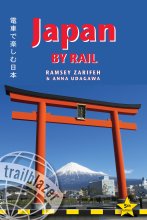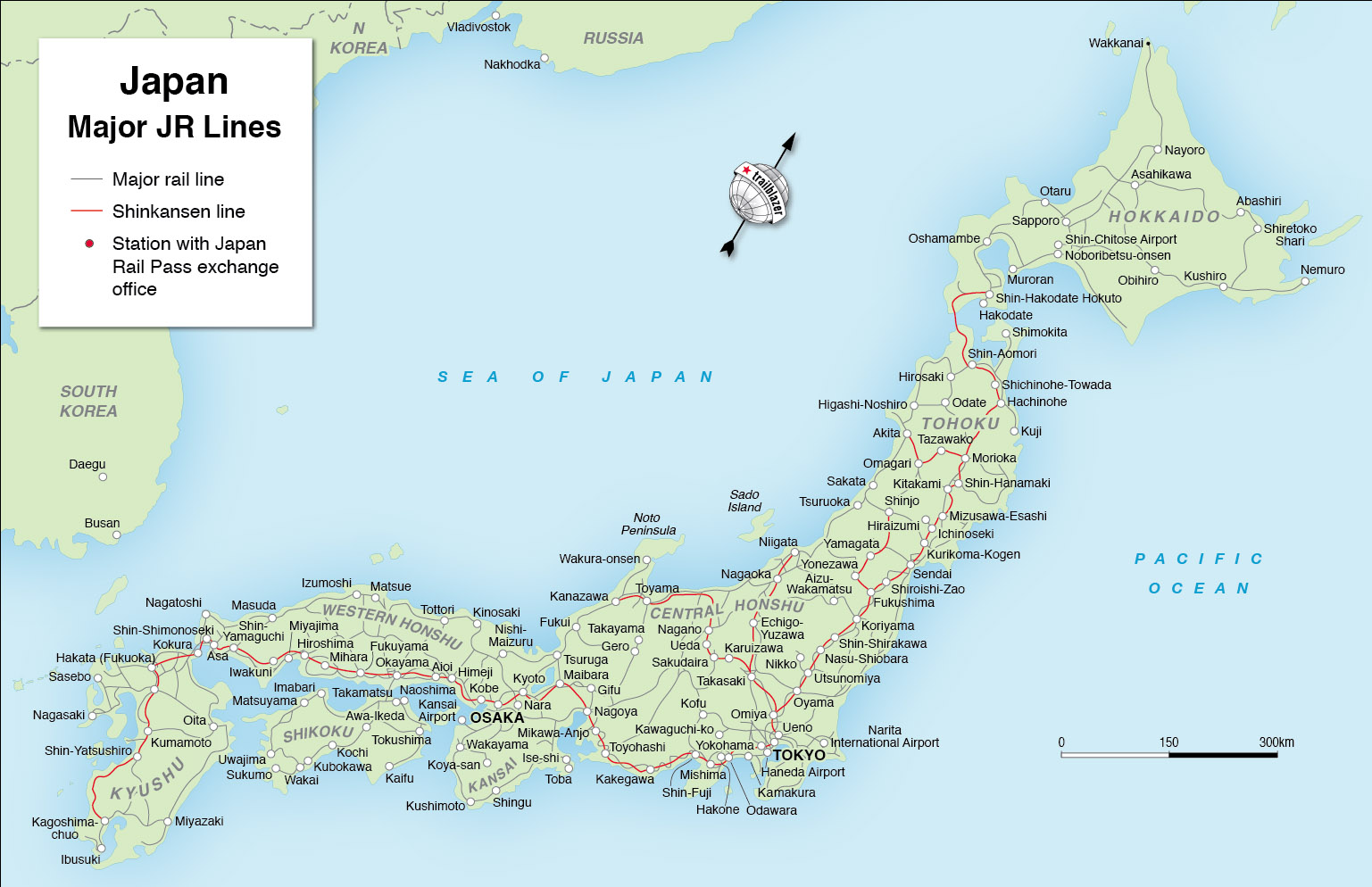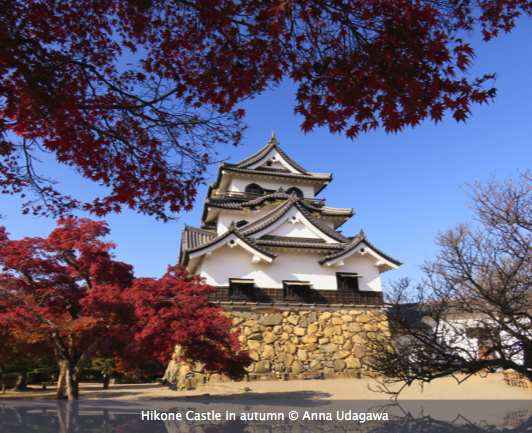I've said it before and I'll say it again, Trailblazer guides take some beating.
— Adventure Travel

Japan by Rail
Excerpt:
Routes and costs; When to go
Contents | Introduction | Routes and costs; When to go | Rail Passes | Sample route guide: Tokyo to Nagoya by shinkansen | Side trip to Miyajima | Off the beaten track sightseeing
Routes and costs
ROUTE OPTIONS
So you know you’re going to Japan: the next step is to work out what you want to see and how much ground you want to cover once you’ve arrived. This guide shows you how travelling around Japan by rail is the best way of seeing the country close up and in full colour. And there are few places in the world where it really can be as much fun to travel as it is to arrive. Welcome to Japan by rail.

Using this guide
Japan Rail (JR) boasts that its network covers every corner of Japan’s four main islands. If you look at the maps in JR’s timetable you’ll see what appears to be something like a bowl of spaghetti. The choice of routes is, if not infinite, at the very least overwhelming. And that is only the JR lines – there are also lines operated by private railway companies. In some places the private railways provide the only service available and in others their stations are in more convenient places for sightseeing; for this edition there’s additional information about these lines.
To simplify travel planning and to reassure the first-time visitor that a qualification in orienteering is not needed, this guide splits the largest island, Honshu, into regions – Central Honshu, Kansai, Western Honshu and Tohoku (North-eastern Honshu) – and suggests (connecting) routes for each of these as well as for the other three main islands: Hokkaido, Kyushu and Shikoku. For example, if you are following the route round Western Honshu you will pass through Okayama, the starting point for the route guide around Shikoku.
Each section begins with an introduction to the area, with information on regional highlights and suggested stopping-off points. Routes can be followed in reverse but in this case all points of interest from the train will be on the opposite side.
Though it’s possible to travel every route by local train, it’s assumed that most travellers will have a rail pass so will use the shinkansen and/or limited express (LEX) services. It is not possible to mention every station so, as a rule of thumb, only stops served by limited expresses (or by shinkansen if the route follows a shinkansen line) are included. Stations served solely by local trains are listed only if they, or the area around them, are of particular interest. The fastest point-to-point journey times are provided for each section of the route.
Even though each route has been divided into different sections it may not be necessary to change train as you go from one section to the next. Occasionally, however, it is essential to change train in order to complete the route described. Such instances are noted in the text. Places which are served by local trains only are also marked.
Sample itineraries are provided on pp41-7.
For the main shinkansen, limited express and local JR services see the summaries on pp504-13.
COSTS
Contrary to popular belief, a visit to Japan doesn’t have to be expensive but it is important to plan your budget as it is an easy country to spend money in.
Package tours which include travel by rail (see pp37-9) rarely offer better value than organising an independent trip. From the UK you’re probably looking at a minimum of £3000 for a 14-day tour including return flights, rail travel, accommodation in basic Japanese inns, some meals and the services of a tour guide. Given the price of a 14-day rail pass (¥46,390: £290/US$408), it would certainly be more cost effective (and more fun) to organise your own trip.
Though the cost of a Japan Rail Pass (see box p30) may seem high, a pass can almost pay for itself in just two journeys on a shinkansen. For example, a 7-day rail pass costs ¥29,100 (£182/US$256; free seat reservations) but the return fare including reserved seat on a shinkansen between Tokyo and Hiroshima costs ¥37,120 (£232/US$327); even just going to and from Kyoto costs ¥27,200 (£170/US$239). A return journey to Kagoshima-chuo by shinkansen from Tokyo works out at ¥59,720 (£373/US$526), more than the cost of a 14-day pass (see p13). For additional sample fares, see box p99.
Sample daily budgets
Note: The budgets below do not include general travel costs because they assume you have a Japan Rail Pass. The exchange rates are rounded up/down for convenience.
Low
Accommodation ¥3000+ (£19/US$26+): dorm bed in a hostel, no meals
Breakfast ¥600 (£4/US$5): coffee and toast
Lunch ¥600 (£4/US$5): sandwich or snack and drink
Dinner ¥1200 (£7/US$11): noodles/pasta, or a hostel meal
Sightseeing# ¥1700 (£11/US$15): less if you mainly visit free attractions
Total ¥7100+ (£44/US$63+)
Mid-range
Accommodation ¥6000 (£37/US$53)+ for a single room, ¥9000 (£56/US$79)+ for
two sharing in a business hotel (breakfast is usually included);
¥8000pp (£50/US$70)+ in a minshuku (half board)
Breakfast* ¥800 (£5/US$7): egg, ham, toast and coffee
Lunch ¥1200 (£7/US$11): lunch deal in a café/restaurant
Dinner ¥1700 (£11/US$15): set evening meal at a restaurant
Sightseeing# ¥1700 (£11/US$15): more if you visit lots of galleries/museums
Total ¥11,400+ (£71/US$100+)
High
Accommodation ¥12,000+ (£75/US$106+) for a single room,
¥20,000+ (£125/US$176) for two sharing in an upmarket hotel;
¥16,000+ (£100/US$141) per person half board in a ryokan
Breakfast* ¥2200 (£14/US$19): buffet breakfast
Lunch ¥4000 (£25/US$35): a three-course meal
Dinner ¥6300+ (£39+/US$55+): à la carte meal
Sightseeing# ¥9000+ (£56+/US$79+): guided city tours and entry fees
Total ¥33,500+ (£209/US$295+)
* If not included in room rate # including a one-day tram/bus/subway pass

WHEN TO GO
In general, Japan has a mild climate, though it’s difficult to talk at all generally about a country which stretches for some 3000km north to south. It can be below freezing and snowing in Hokkaido while southern Kyushu is enjoying sunshine and mild temperatures.
April and May are often considered the best months to visit, when the worst of the Hokkaido winter is over and the rest of Japan is not yet sweltering in humidity. The cherry blossom season is eagerly anticipated and the Japan Meteorological Agency (JMA; www.jma.go.jp) has an internet page dedicated to reporting when the blossoms are forecast to flower. Although each year is different, the season starts in Kyushu, generally mid to late March, and progresses northwards climaxing in Hokkaido in May.
However, try to avoid the school/university holidays from late March to early April and the so-called Golden Week (29th April to 5th May), which includes four national holidays and can feel as if the entire country is on the move; hotels and trains are booked out and prices rise to meet demand. The latter part of May is a lovely time to be in Japan as the weather is often good but it isn’t too hot.
The rainy season in June/ July (with occasional typhoons) marks the change from spring to summer but the showers are soon replaced by heat and humidity. Humidity is high throughout the summer months so carry bottled water if you are planning long days of sightseeing at this, the hottest, time of the year. Hokkaido is by far the coolest and least humid place in summer, which also makes it one of the busiest. The school holiday season in August is another busy time, particularly around mid August during the Obonfestival when people head back to their home towns.
The high temperatures and – particularly in the south – blistering heat can last well into September and often there is a lot of rain then. Typhoons strike coastal regions, particularly in Kyushu, Shikoku and Kansai in late summer. Fortunately these are usually predicted a day or two before they hit so it’s unlikely you will be taken unawares.
By the beginning of October things usually cool down and dry up. Late October and November are the months for viewing the autumn leaves (koyo); this can be a spectacular time to visit. The sky is often clear so views are better and you also have more chance of seeing Mt Fuji. The autumn colours begin their magnificent display in Hokkaido and gradually move south through the islands, in the opposite direction to the cherry-blossom wave.
If you don’t mind the cold, December and January are also good times, especially for skiing.
New Year is another major holiday period and even though the weather may be fine many places get crowded.
Japan by Rail
Excerpts:
- Contents
- Introduction
- Routes and costs; When to go
- Rail Passes
- Sample route guide: Tokyo to Nagoya by shinkansen
- Side trip to Miyajima
- Off the beaten track sightseeing
Price: £19.99 buy online now…
Latest tweets